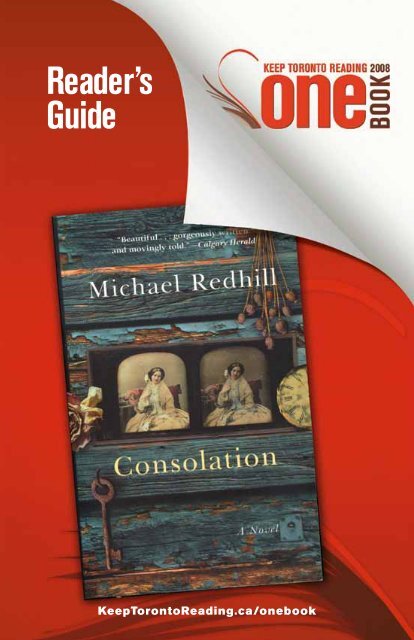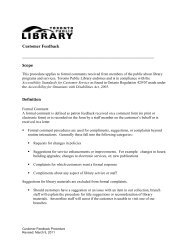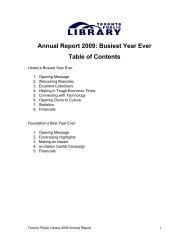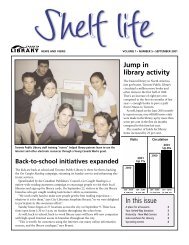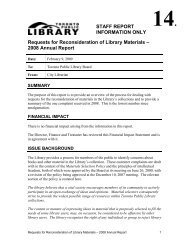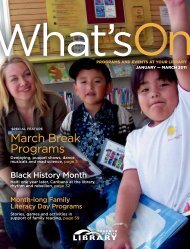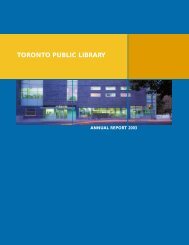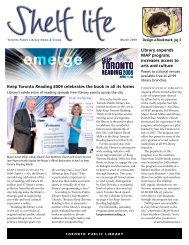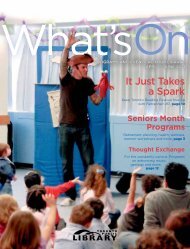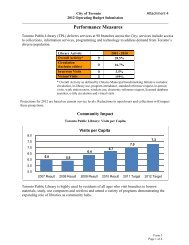Download One Book Reader's Guide (PDF) - Toronto Public Library
Download One Book Reader's Guide (PDF) - Toronto Public Library
Download One Book Reader's Guide (PDF) - Toronto Public Library
Create successful ePaper yourself
Turn your PDF publications into a flip-book with our unique Google optimized e-Paper software.
Reader’s<br />
<strong>Guide</strong><br />
Keep<strong>Toronto</strong>Reading.ca/onebook
Program Partners<br />
“I’m delighted to have Consolation chosen<br />
as the <strong>Toronto</strong> <strong>Public</strong> <strong>Library</strong>’s inaugural<br />
<strong>One</strong> <strong>Book</strong>. I consider the novel a love letter<br />
to <strong>Toronto</strong> and it thrills me to have it requited.”<br />
– Michael Redhill<br />
<br />
Jarvis Collegiate<br />
Sir Sandford Fleming Academy<br />
R.H. King Academy<br />
The York School
Join <strong>Toronto</strong>’s first annual<br />
community read project<br />
Imagine if everybody in <strong>Toronto</strong> were on the same page.<br />
Michael Redhill’s <strong>Toronto</strong> <strong>Book</strong> Award-winning novel Consolation<br />
is our first <strong>One</strong> <strong>Book</strong> selection. A haunting story of <strong>Toronto</strong>’s<br />
vanished past and changing present, Consolation digs beneath<br />
the surfaces of the city and its inhabitants to raise compelling<br />
questions about progress, loss and the nature of history.<br />
All month long, the <strong>Toronto</strong> <strong>Public</strong> <strong>Library</strong> and our partners<br />
throughout the city will be holding author events, book giveaways,<br />
walking tours, in-person and online discussions and more.<br />
Consult Keep<strong>Toronto</strong>Reading.ca/onebook for dates, times,<br />
locations and details.<br />
Praise for Consolation<br />
“Some of the best historical fiction about <strong>Toronto</strong>… Home and<br />
muse, the city that has ignited Redhill’s imagination will captivate<br />
and haunt the imagination of readers of this luminous novel.”<br />
– Vancouver Sun<br />
“A beautiful and dreamy story, gorgeously written and movingly<br />
told, about the myriad ways the past lingers just below the<br />
surface of the present and inevitably shapes the future. It<br />
is the story of a family, but also the story of <strong>Toronto</strong>, a city<br />
that’s constantly re-creating itself and, in so doing, constantly<br />
shrugging off its awkward past. Redhill’s recreation of old<br />
<strong>Toronto</strong> is so vivid you can almost hear the rumble of carriage<br />
wheels on the cobblestones as you turn the pages.”<br />
– Calgary Herald
A warm welcome from the mayor<br />
<strong>One</strong> of the qualities that makes <strong>Toronto</strong> great is the vast range of<br />
opportunities it offers for cultural engagement and civic dialogue.<br />
I’m thrilled to support the latest addition to the city’s cultural life:<br />
Keep <strong>Toronto</strong> Reading <strong>One</strong> <strong>Book</strong>.<br />
The selection of Consolation as our first title not only celebrates<br />
our city, but also showcases the work of one of <strong>Toronto</strong>’s most<br />
talented authors. Michael Redhill’s novel raises many issues of<br />
great urgency to <strong>Toronto</strong>: can we reconcile the need to preserve<br />
the city’s past with its rapid growth? In a city constantly renewed<br />
by immigration, how do we create our environment, and how<br />
does it change us? How do we look after the needs of the most<br />
vulnerable among us?<br />
I look forward to all of us coming together to discuss these vital<br />
ideas and to celebrate the wealth of literature we have in <strong>Toronto</strong>.<br />
Mayor David Miller<br />
Rossin House, 1867. Octavius Thompson.<br />
<strong>Toronto</strong> Reference <strong>Library</strong><br />
2 Michael Redhill Consolation
Josephine Bryant<br />
Kathy Gallagher Ross<br />
greetings from the Chief librarian<br />
and the Board chair<br />
For three years now, Keep <strong>Toronto</strong> Reading has brightened up<br />
the winter by bringing people together for the month of February<br />
to celebrate the joy of reading. This year, for the first time, we’re<br />
taking it a step further by inviting all of <strong>Toronto</strong> to join a city-wide<br />
book club. Welcome to Keep <strong>Toronto</strong> Reading <strong>One</strong> <strong>Book</strong>.<br />
We’re proud to present Michael Redhill’s wonderful novel,<br />
Consolation, as our first <strong>One</strong> <strong>Book</strong> selection. We’re sure that<br />
the people of <strong>Toronto</strong> will find much to discuss in this vivid,<br />
complex and moving story of the city’s past and present.<br />
We, and our partners across the city, invite you to participate<br />
in the many events exploring and celebrating Consolation<br />
throughout the month. Borrow one of our many copies of the<br />
book, come out to a reading, a panel discussion, or a walking<br />
tour and see what it’s like when everybody’s on the same page.<br />
Chief Librarian,<br />
<strong>Toronto</strong> <strong>Public</strong> <strong>Library</strong><br />
Chair, <strong>Toronto</strong> <strong>Public</strong><br />
<strong>Library</strong> Board<br />
Keep<strong>Toronto</strong>Reading.ca/onebook • <strong>One</strong> <strong>Book</strong> Reader’s <strong>Guide</strong> 3
About Consolation<br />
There is a vast part of this city with mouths buried in it… Mouths capable of<br />
speaking to us. But we stop them up with concrete and build over them and<br />
whatever it is they wanted to say gets whispered down empty alleys and turns<br />
into wind…<br />
These are among the last words of Professor David Hollis before he throws<br />
himself off a ferry into the frigid waters of Lake Ontario. A renowned professor<br />
of forensic geology, David leaves in his wake both a historical mystery and an<br />
academic scandal. He postulated that on the site where a sports arena is about<br />
to be built lie the ruins of a Victorian boat containing an extraordinary treasure:<br />
a strongbox full of hundreds of never-seen photographs of early <strong>Toronto</strong>, a<br />
priceless record of a lost city. His colleagues, however, are convinced that he<br />
faked his research materials.<br />
Determined to vindicate him, his widow, Marianne, sets up camp in a hotel<br />
overlooking the construction site, watching and waiting for the boat to be<br />
unearthed. The only person to share her vigil is John Lewis, fiancé to her<br />
daughter, Bridget. An orphan who had come to love David as his own father,<br />
John finds himself caught in a struggle between mother and daughter, all the<br />
while keeping a dark secret from both women.<br />
Interwoven into the contemporary story is another narrative set in 1850s<br />
<strong>Toronto</strong>: the tale of Jem Hallam, a young apothecary struggling to make a living<br />
in the harsh new city so he can bring his wife and daughters from England.<br />
Crushed by ruthless competitors, he develops an unlikely friendship with two<br />
other down-on-their-luck <strong>Toronto</strong>nians: Samuel Ennis, a brilliant but dissolute<br />
Irishman, and Claudia Rowe, a destitute widow. Together they establish a<br />
photography business and set out to create images of a fledgling city where<br />
wooden sidewalks are put together with penny nails; where Indians spear<br />
salmon at the river mouth and the occasional bear ambles down King Street;<br />
where department stores display international wares and fine mansions sit<br />
cheek-by-jowl with shantytowns.<br />
Consolation moves back and forth between David Hollis’s legacy and Jem<br />
Hallam’s struggle to survive, ultimately revealing a mysterious connection<br />
between the two narratives. Exquisitely crafted and masterfully written, Michael<br />
Redhill’s superlative book reveals how history is often transformed into a species<br />
of fantasy, and how time alters the contours of even the things we hold most<br />
certain. As complex and layered as the city whose story it tells, Consolation<br />
evokes the mysteries of love and memory, and what suffering the absence of the<br />
beloved truly means.<br />
4 Michael Redhill Consolation
Photo of Michael Redhill: Cylla Von Tiedemann<br />
About the Author<br />
Michael Redhill is the publisher and one of the editors of Brick, a<br />
literary magazine; the author of the novel Martin Sloane, a finalist<br />
for the 2001 Giller Prize; and the short story collection Fidelity.<br />
He has also written four poetry collections, including Asphodel,<br />
published in 1997, and Light-Crossing, published in 2001. His<br />
most recent works for the theatre are Goodness and Building<br />
Jerusalem, winner of a Dora Award.<br />
Consolation, Redhill’s second novel, was awarded the 2007<br />
<strong>Toronto</strong> <strong>Book</strong> Award and nominated for the 2007 Man <strong>Book</strong>er<br />
prize.<br />
Michael Redhill is currently spending a year in France with his<br />
partner and their two sons.<br />
Keep<strong>Toronto</strong>Reading.ca/onebook • <strong>One</strong> <strong>Book</strong> Reader’s <strong>Guide</strong> 5
Looking north-east (left and middle) and east on King (p. 7) from the top of the Rossin House,<br />
circa 1856. Armstrong, Beere & Hime. <strong>Toronto</strong> Reference <strong>Library</strong> and City of <strong>Toronto</strong> Archives<br />
“I knew there was something in the pictures I wanted to write about.<br />
But the more I scribbled things down, the more I began to recognize a<br />
resonance between that dead city, no stitch of which exists anymore,<br />
and modern <strong>Toronto</strong>.”<br />
– Michael Redhill<br />
Jem Hallam’s <strong>Toronto</strong><br />
Barbara Myrvold, Librarian and Historian, <strong>Toronto</strong> <strong>Public</strong> <strong>Library</strong><br />
When Jem Hallam, hero of Michael Redhill’s Consolation, arrived<br />
in <strong>Toronto</strong> in 1856, he came to a city on the verge of great<br />
change, one that would be almost unrecognizable to residents<br />
today. At the time, the city was essentially bordered by Dufferin<br />
Street, Lake Ontario, the Don River and Bloor Street.<br />
With 30,775 residents in 1851, it was the largest city in<br />
Canada West (now Ontario), but was considerably smaller than<br />
Montreal (57,715) and Quebec City (42,052) in Canada East.<br />
Although growth had slowed from the previous two decades,<br />
<strong>Toronto</strong>’s population still increased almost 45 percent between<br />
1851 and 1861, when the city’s population reached 44,821.<br />
Some of <strong>Toronto</strong>’s most striking buildings went up in the late<br />
1840s and 1850s, including the Provincial Lunatic Asylum and<br />
Trinity College on Queen Street West near the city limits, <strong>Toronto</strong><br />
Mechanics’ Institute (the predecessor of <strong>Toronto</strong> <strong>Public</strong> <strong>Library</strong>),<br />
St. Michael’s Cathedral, St. Lawrence Hall, St. James Cathedral<br />
and University College, to name a few. Several of these buildings<br />
survive to enrich today’s <strong>Toronto</strong>.<br />
6 Michael Redhill Consolation
Michael Redhill’s inspiration for Consolation included a panoramic series of<br />
photographs taken in 1856 from atop the Rossin House Hotel, located at the<br />
corner of King and York Streets until 1969. See the photos that inspired Redhill<br />
on display at <strong>Toronto</strong> Reference <strong>Library</strong> and City of <strong>Toronto</strong> Archives in February.<br />
<strong>Toronto</strong>’s People<br />
Despite his initial loneliness and isolation, the fictional Hallam<br />
shared a similar background and experiences with the majority of<br />
<strong>Toronto</strong>nians of the time. With two-thirds born outside of Canada<br />
in 1851, <strong>Toronto</strong> was a city of immigrants. Ninety percent of the<br />
newcomers had emigrated from Great Britain. The so-called<br />
“foreign-born,” those whose birthplace was neither Canada nor<br />
Britain, came from the United States, Germany, Holland and “all<br />
other places.”<br />
These modest numbers increased over time, as did the variety<br />
of source countries, contributing to the city’s diversity. <strong>Toronto</strong>’s<br />
Black population swelled to 526 residents in 1851; Canada<br />
became a safe haven once the United States passed the Fugitive<br />
Slave Act (1850).<br />
Religion reflected the Anglo-Celtic origin of most <strong>Toronto</strong>nians.<br />
Three-quarters were Protestant in 1851. The Church of England<br />
comprised the largest group with 37 percent. The exodus from<br />
famine-stricken Ireland in the late 1840s had given <strong>Toronto</strong> a<br />
sizeable Roman Catholic population (25 per cent in 1851). Jews,<br />
the only non-Christians, formed less than one percent, but their<br />
population tripled during the decade from 57 to 153 in 1861.<br />
The Changing Face of <strong>Toronto</strong><br />
Immigration was not the only force changing the city. <strong>Toronto</strong><br />
entered the railway era on May 16, 1853 when the <strong>Toronto</strong><br />
steam-engine of the Ontario, Simcoe & Huron Railroad pulled<br />
four cars to Machell’s Corners (Aurora); by the end of the<br />
decade, service extended in all directions — to Collingwood on<br />
Keep<strong>Toronto</strong>Reading.ca/onebook • <strong>One</strong> <strong>Book</strong> Reader’s <strong>Guide</strong> 7
the Northern, to Sarnia and Montreal on the Grand Trunk, and via<br />
the Great Western’s Hamilton link, to London and the American<br />
Midwest.<br />
As its regional reach extended more widely, the city’s<br />
commercial institutions also grew. The <strong>Toronto</strong> Stock Exchange<br />
was established in 1852, the Canada Permanent Buildings<br />
and Savings Society in 1855 and the Bank of <strong>Toronto</strong> in 1856.<br />
Reflecting this rising prosperity, the Rossin House, a five-storey<br />
luxury hotel, opened at King and York in May 1857. Hand in hand<br />
with these developments, <strong>Toronto</strong> suffered a severe crash in 1857,<br />
and the economic downturn lasted well into the early 1860s.<br />
The physical face of the city began to change, as <strong>Toronto</strong><br />
became the main railway hub of Canada West. The railways’<br />
need for land led to a 100-foot landfill strip across the harbour in<br />
the mid-1850s, the beginning of the eastern Esplanade and the<br />
first of many lakefills, which would gradually move the shoreline<br />
southwards.<br />
Industrial and residential areas started to separate, at least<br />
for the more affluent. By 1851, most <strong>Toronto</strong>nians lived north of<br />
Queen. For the wealthy, Rosedale was planned in 1854 with villa<br />
lots on winding streets — the first break from <strong>Toronto</strong>’s historic<br />
grid pattern. Migration north (and west) continued in the 1850s,<br />
as the gentry subdivided original park lots between Queen and<br />
Bloor and laid out new streets, targeting working and middle<br />
classes. Slums including Macauleytown became more congested<br />
as poor immigrants crammed into shoddy shanty dwellings.<br />
Growth of Services<br />
In spite of poverty and crowding, the crumbling, fire-prone slums<br />
where Hallam first meets Ennis and Rowe in Consolation were<br />
changing in the 1850s, as government services and regulations<br />
increased. Sewers and gaslights, installed on many streets<br />
in the 1840s, were expanded to new areas. Roads were laid<br />
with macadam and sidewalks with plank boards. Following the<br />
great fire of 1849, the city required new development in the<br />
downtown area to be more fire-resistant. Nevertheless, almost<br />
three-quarters of <strong>Toronto</strong>’s 8,438 houses were frame in 1861,<br />
although the proportion of brick dwellings was increasing and<br />
shanties had disappeared; fewer than 40 houses were stone.<br />
Four fire stations operated in 1856; steam-powered fire engines<br />
replaced hand-pumped machines by 1861.<br />
8 Michael Redhill Consolation
There was… a science to determining how time passes. Human beings<br />
interrupt the natural cycles of growth and decay with their communities<br />
and their structures, but they don’t stop those cycles. Rather, the<br />
process is continued, like river water flowing around a stone. Except<br />
the river water is made of cities and buildings, and the stone is pushed<br />
underground and lost forever…<br />
– Consolation<br />
Work and Leisure<br />
<strong>Toronto</strong>nians worked at many jobs in the 1850s, with labourers<br />
and female servants comprising the two largest groups. The<br />
fictional Hallam’s occupations expanded over the course of the<br />
decade; the number of “chemists, druggists and apothecaries”<br />
doubled from 29 to 57, while four “daguerrists” were transformed<br />
into 12 “photographists.” Armstrong & Beere, the real-life firm<br />
who took the photographs of <strong>Toronto</strong> that inspired Consolation,<br />
advertised itself in 1855-6 as “Engineers, Draughtsmen and<br />
Photographists over Simpson & Dunspaugh, Chemists, King<br />
Street.” (A third ‘photographist’, Humphrey Lloyd Hime, joined the<br />
firm in 1857.)<br />
King Street was the city’s main commercial, cultural and<br />
ceremonial thoroughfare. <strong>Toronto</strong>’s three daily newspapers were<br />
located there – George Brown’s Globe, James Beaty’s Leader<br />
and the Colonist, edited by Samuel Thompson. St. Lawrence<br />
Hall, on King East, offered sophisticated activities including<br />
recitals by the Swedish Nightingale, Jenny Lind, and lectures by<br />
the American abolitionist, Frederick Douglass. The Royal Lyceum<br />
Theatre, next to the Rossin House, was a principal stop for<br />
touring companies.<br />
Travelling circuses led parades through the city to the Fair<br />
Green on the lakeshore. People danced the Elephant Polka<br />
and the Grand Trunk Mazurka at charity and military balls. In the<br />
summertime, pleasure steamers went to <strong>Toronto</strong> Island (actually<br />
a peninsula until a violent storm in 1858). There was a wide<br />
variety of societies to support the less fortunate, including the<br />
“deserving” and “undeserving” poor. For some, social activities<br />
centred at the city’s 35 churches, while for others leisure hours<br />
were spent at <strong>Toronto</strong>’s 200 hotels, taverns and saloons.<br />
Keep<strong>Toronto</strong>Reading.ca/onebook • <strong>One</strong> <strong>Book</strong> Reader’s <strong>Guide</strong> 9
6<br />
<strong>Toronto</strong> 1856<br />
Detail from Plan of the City of <strong>Toronto</strong>,<br />
Charles Unwin, 1858. <strong>Toronto</strong> Reference<br />
<strong>Library</strong><br />
You can also explore <strong>Toronto</strong> then and<br />
now with our online, interactive map at<br />
Keep<strong>Toronto</strong>Reading.ca/onebook
5<br />
7<br />
2<br />
1<br />
4<br />
3<br />
Legend of COnsolation locations 1. J. Hallam, Apothecary<br />
2. Rossin House Hotel 3. Browne’s Wharf 4. Parliament Buildings<br />
5. Osgoode Hall 6. Samuel Ennis’s Shanty 7. Jem Hallam’s Rooms
Gould Street Presbyterian Church, circa 1856. Photo by Armstrong,<br />
Beere and Hime. City of <strong>Toronto</strong> Archives.<br />
Excerpt from Consolation<br />
…He remembered freshly his first glimpse of the city, as the<br />
ferry came around the western side of the island that lay off its<br />
shore: a vision of spires and yellow brick and white stone set<br />
against a wall of trees. And from that distance — even as the ferry<br />
bore down on Brown’s Wharf at the foot of Yonge Street — the<br />
seeming feebleness of the little twists of smoke and steam rising<br />
up from different buildings, Lilliputian industry while all around<br />
it raw nature went about its effortless business. Who thinks of<br />
making a city in the rough? he’d thought, seeing the place for the<br />
first time, and he knew from the expressions on the faces of the<br />
newly arrived that this was the wondering thing that occurred to<br />
everyone that made landfall here.<br />
Some greater shocks were in store for those brave enough<br />
to leave their ships. Streets paved with little more than the<br />
accumulation of grit pressed into them by boots. Wooden
Osgoode Hall, circa 1856. Photo by Armstrong, Beere and Hime.<br />
City of <strong>Toronto</strong> Archives.<br />
“I doubt a four-foot piece of the True Cross would be enough to<br />
stop work on a site in this city. You find a three-week-old potato<br />
chip in Montreal, they raise a velvet rope around it and have a<br />
minute of silence. But here, no.”<br />
sidewalks put together with penny nails. Tar-acrid log shanties<br />
with bank buildings made of Kingston stone in their backyards.<br />
German and French spoken freely in the streets and canoes out<br />
in the lake with actual Indians in them, spearing salmon at the<br />
river mouth. Then that same lake, frozen to stillness between<br />
December and April, ice-clenched with nothing coming in or out<br />
of it. And centred in it, with misplaced pride, a stuttering attempt<br />
at making an English town out of nothing, like a voice straining to<br />
be heard from a great distance. It would actually be funny, Hallam<br />
had thought, if he didn’t have to live here.<br />
Excerpt from Consolation by Michael Redhill. Copyright © 2006 Caribou River Ltd.<br />
Published by Doubleday Canada. Reproduced by arrangement with the Publisher.<br />
All rights reserved.<br />
For a digitized and annotated excerpt from the book,<br />
go to Keep<strong>Toronto</strong>Reading.ca/onebook<br />
Keep<strong>Toronto</strong>Reading.ca/onebook • <strong>One</strong> <strong>Book</strong> Reader’s <strong>Guide</strong> 13
Questions for Discussion<br />
1. In an interview with <strong>Toronto</strong> Life, Michael Redhill said that he<br />
wrote Consolation out of love and anger. How do you see<br />
these two motivations at play in the novel?<br />
2. Marianne says to John: “You make no choices. You allow<br />
yourself to be moved by other things… You’re like powder<br />
that has to have some ingredient added to make it active.”<br />
Do you agree with her judgment or do you think she’s too<br />
hard on John? How does John grow as a character over the<br />
course of the novel?<br />
3. John says to Marianne, with respect to her husband, “You<br />
loved him, but you didn’t accept him.” Would you call this a<br />
fair comment and why or why not?<br />
4. Why do you think the author chose to leave the end of the<br />
novel open? How would the stories continue in your view?<br />
Does Jem return to <strong>Toronto</strong> to be with Claudia? Can John<br />
and Bridget ever pick up where they left off?<br />
5. Do you think that the character Howard Rosen is correct in<br />
thinking that Sam was based on him?<br />
6. “Time was linear: it went forward and back. But up and<br />
down was organic, it was growth and decay.” Discuss the<br />
theme of time in relation to photography, urban development<br />
and the characters’ subjective experiences.<br />
7. What resonances, if any, did you notice between the<br />
historical and contemporary narratives?<br />
8. Both David Hollis and Jem Hallam comment on the isolation<br />
experienced by <strong>Toronto</strong>nians. For David, it’s a symptom of<br />
modernity. For Jem, it’s the result of a harsh climate. Do you<br />
agree with either view?<br />
9. Both David Hollis and Sam Ennis, as dying men, describe<br />
themselves as lucky. Why do you think they feel this way?<br />
14 Michael Redhill Consolation
10. David asks John, “Do you think you’re awake?” What<br />
does he mean by that? How would you answer that same<br />
question?<br />
11. Discuss the role of family in Consolation, especially with<br />
respect to John and Jem.<br />
12. Do you think the struggles of Victorian and modern-day<br />
<strong>Toronto</strong> are all that different? Why or why not?<br />
13. How does the <strong>Toronto</strong> depicted in Consolation compare<br />
with the view you have of the city either first-hand, or<br />
through other books you’ve read or movies you’ve seen?<br />
Did the novel change the way you look at your own<br />
community — its past, present and future?<br />
14. Loss permeates the novel — loss of life, love and the<br />
remnants of the past. How do the main characters cope<br />
with loss? How are they consoled?<br />
15. Were you surprised to find out who narrates Jem Hallam’s<br />
story? How did the discovery affect your reading of the<br />
novel as a whole?<br />
16. Jem refused to mail his letters to his family because they<br />
were “full of lies too egregious for sending.” Howard Rosen<br />
described John’s manuscript as “trying to fix a lie with<br />
another lie.” Discuss the role of deceit in the novel.<br />
17. Both Jem and David are faced with tremendously difficult<br />
decisions: Jem, to let Claudia stay with him or fend for<br />
herself; John, whether or not to drive David to the ferry<br />
docks — and his death. Do you think each character makes<br />
the right choice?<br />
Keep<strong>Toronto</strong>Reading.ca/onebook • <strong>One</strong> <strong>Book</strong> Reader’s <strong>Guide</strong> 15
Court Street Firehall, 1860.<br />
<strong>Toronto</strong> Reference <strong>Library</strong><br />
Events<br />
Meet the author<br />
Celebrate the launch of our first <strong>One</strong> <strong>Book</strong> program featuring<br />
music by Mary Lou Fallis, dramatic readings, and a discussion<br />
with Consolation author Michael Redhill.<br />
Monday, February 4, 7 p.m., <strong>Toronto</strong> Reference <strong>Library</strong><br />
Bring your copy of Consolation to a candle-lit dinner with<br />
Michael Redhill at historic Gibson House and experience <strong>Toronto</strong><br />
as it was in the 1850s.<br />
$25. Pre-payment and pre-registration required.<br />
Phone 416-395-7432 for reservations.<br />
Tuesday, February 5, 7 p.m., Gibson House Museum,<br />
5172 Yonge St., North York Centre Subway<br />
<strong>Book</strong> signing with Michael Redhill.<br />
Wednesday, February 6, 1:30 p.m., Nicholas Hoare <strong>Book</strong>s,<br />
45 Front St. E.<br />
Join <strong>Toronto</strong> <strong>Public</strong> <strong>Library</strong> book club members in an informal<br />
chat with the author of Consolation.<br />
Wednesday, February 6, 6:30 p.m., North York Central <strong>Library</strong>,<br />
Concourse. Open to all.<br />
Submit your questions to author Michael Redhill at our online<br />
book club: bookbuzz.torontopubliclibrary.ca.<br />
16 Michael Redhill Consolation
Experience the <strong>Book</strong><br />
<strong>Book</strong> Talks<br />
Ryerson professor and book lover Suanne Kelman presents an<br />
in-depth look at Consolation.<br />
Thursday, February 7, 2 p.m., Brentwood Branch<br />
Thursday, February 7, 7 p.m., Beaches Branch<br />
Tuesday, February 12, 7 p.m., Don Mills Branch<br />
Friday, February 22, 1:30 p.m., Agincourt Branch<br />
Lost City<br />
Preservationists and developers debate <strong>Toronto</strong>’s past and future.<br />
Monday, February 11, 7 p.m., St. Lawrence Hall, 157 King St. E.<br />
First Days<br />
A panel of immigrant writers – including authors Shyam<br />
Selvadurai and Goran Simic — discuss their early days in <strong>Toronto</strong>,<br />
and share memories of the hope and the loneliness of arrival in a<br />
new city.<br />
Wednesday, February 13, 7 p.m., Parkdale Branch<br />
In the Footsteps of the Black Victorians – A Walking Tour<br />
Saturday, February 16, 1 to 3 p.m., St. Lawrence Market.<br />
Mackenzie House admission of $4 applies. Please RSVP.<br />
Call 416-392-6915 for details.<br />
All Month:<br />
• Visit Keep<strong>Toronto</strong>Reading.ca/onebook to download Michael<br />
Redhill’s audio walking tour and to view an annotated and<br />
illustrated virtual chapter of Consolation<br />
• Check out CBC Radio’s Here and Now with Matt Galloway and<br />
the <strong>Toronto</strong> Star for <strong>One</strong> <strong>Book</strong> news and programs<br />
• Visit Spacing <strong>Toronto</strong> at spacing.ca/toronto for articles from<br />
contributing writers about Consolation’s <strong>Toronto</strong><br />
• Discuss Consolation at the <strong>Toronto</strong> <strong>Public</strong> <strong>Library</strong>’s online book<br />
club: bookbuzz.torontopubliclibrary.ca<br />
• Check Keep<strong>Toronto</strong>Reading.ca/onebook for updated details<br />
and new activities<br />
Keep<strong>Toronto</strong>Reading.ca/onebook • <strong>One</strong> <strong>Book</strong> Reader’s <strong>Guide</strong> 17
Parliament Buildings, circa 1856.<br />
Photo by Armstrong, Beere and Hime.<br />
<strong>Toronto</strong> Reference <strong>Library</strong> and City of<br />
<strong>Toronto</strong> Archives.<br />
Exhibits<br />
See <strong>Toronto</strong> in pictures as<br />
it was in the 1850s.<br />
• View the photographs that inspired Consolation at the <strong>Toronto</strong><br />
Reference <strong>Library</strong> or the City of <strong>Toronto</strong> Archives.<br />
• Visit <strong>Toronto</strong> Culture Division’s exhibits, A Glimpse of Black Life<br />
in Victorian <strong>Toronto</strong>, 1850-1860 and The Black Press in Canada<br />
West at the <strong>Toronto</strong> Reference <strong>Library</strong>.<br />
• See virtual exhibits of Victorian <strong>Toronto</strong> online at<br />
historicity.torontopubliclibrary.ca:<br />
• All Aboard <strong>Toronto</strong>! Railways and the Growth of the City<br />
• <strong>Toronto</strong>: A Place of Meeting<br />
18 Michael Redhill Consolation
<strong>Toronto</strong> <strong>Public</strong> <strong>Library</strong>’s <strong>Book</strong> Clubs are<br />
located across the City<br />
Agincourt<br />
Albert Campbell<br />
Alderwood<br />
Annette<br />
Beaches<br />
Bendale<br />
Bloor/Gladstone<br />
Brentwood<br />
Cedarbrae<br />
Cliffcrest<br />
Danforth/Coxwell<br />
Davenport<br />
Deer Park<br />
Don Mills<br />
Downsview<br />
Eatonville<br />
Eglinton Square<br />
Elmbook Park<br />
Fairview<br />
Forest Hill<br />
Goldhawk Park<br />
Guildwood<br />
High Park<br />
Leaside<br />
Locke Branch<br />
Long Branch<br />
Malvern<br />
McGregor Park<br />
Mimico<br />
Morningside<br />
Mount Pleasant<br />
New <strong>Toronto</strong><br />
Northern District<br />
Northern Elms<br />
North York<br />
Central <strong>Library</strong><br />
Palmerston<br />
Pape/Danforth<br />
Parliament<br />
Port Union<br />
Rexdale<br />
Richview<br />
Riverdale<br />
Runnymede<br />
S. Walter Stewart<br />
Sanderson<br />
Spadina<br />
St. Lawrence<br />
Taylor Memorial<br />
Weston<br />
Wychwood<br />
York Woods<br />
Yorkville<br />
<strong>Book</strong> Buzz, an online <strong>Book</strong> Club<br />
Join us for an online discussion of Consolation by going to<br />
www.torontopubliclibrary.ca and clicking on <strong>Book</strong> Clubs.<br />
Keep<strong>Toronto</strong>Reading.ca/onebook • <strong>One</strong> <strong>Book</strong> Reader’s <strong>Guide</strong> 19
Further Reading<br />
Other Works by Michael Redhill<br />
Fiction<br />
Martin Sloane<br />
Doubleday, 2001<br />
Fidelity<br />
Doubleday, 2003<br />
Drama<br />
Building Jerusalem<br />
Playwrights Union Canada, 2001<br />
Goodness<br />
Coach House Press, 2005<br />
Poetry<br />
Impromptu Feats of Balance<br />
Wolsak and Wynn, 1990<br />
Lake Nora Arms<br />
Coach House Press, 1993;<br />
House of Anansi, 2001<br />
Asphodel<br />
McClelland & Stewart, 1997<br />
Light-Crossing<br />
House of Anansi, 2001<br />
Related <strong>Book</strong>s<br />
Fiction<br />
Alias Grace<br />
Margaret Atwood<br />
McClelland & Stewart, 1996<br />
Baldwin Street<br />
Alvin Rakoff<br />
Bunim & Bannigan Ltd., 2007<br />
Cabbagetown<br />
Hugh Garner<br />
McGraw-Hill Ryerson, 1978, 2003<br />
The City Man<br />
Howard Akler<br />
Coach House Press, 2005<br />
In the Skin of a Lion<br />
Michael Ondaatje<br />
McClelland & Stewart, 1987<br />
Natasha and Other Stories<br />
David Bezmozgis<br />
Harper Flamingo Canada, 2004<br />
This Ain’t No Healing Town<br />
edited by Barry Callaghan<br />
Exile Editions, 1995<br />
Under the Dragon’s Tail, Poor Tom is<br />
Cold, A Journeyman to Grief<br />
and other mysteries<br />
Maureen Jennings<br />
McClelland & Stewart<br />
What We All Long For<br />
Dionne Brand<br />
Knopf Canada, 2005<br />
Witness to Life<br />
Terence M. Green<br />
Tom Doherty Assoc., 1999<br />
Non-fiction<br />
Inside <strong>Toronto</strong>: Urban Interiors, 1880s to 1920s<br />
Sally Gibson<br />
Cormorant <strong>Book</strong>s, 2006<br />
I’ve Got a Home in Glory Land: A Lost Tale of the<br />
Underground Railroad<br />
Karolyn Smardz Frost<br />
Thomas Allen, 2007<br />
Lost <strong>Toronto</strong><br />
William Dendy<br />
Oxford University Press, 1978<br />
<strong>Toronto</strong> to 1918: An Illustrated History<br />
J.M.S. Careless<br />
James Lorimer & Co., 1984<br />
A <strong>Toronto</strong> Album: Glimpses of the City That Was<br />
Mike Filey<br />
Dundurn Group, 2001<br />
<strong>Toronto</strong>, No Mean City<br />
Eric Arthur<br />
University of <strong>Toronto</strong> Press, 1986<br />
20 Michael Redhill Consolation
KEEP<br />
TORONTO<br />
READING 2008
<strong>Toronto</strong> <strong>Public</strong> <strong>Library</strong> gratefully acknowledges<br />
The Printing House for their donation of<br />
printing services for the first annual<br />
<strong>One</strong> <strong>Book</strong> Reader’s <strong>Guide</strong>.<br />
www.torontopubliclibrary.ca


